TTE research archive
Micro-magnetic Simulation of Magnetization Switching

Undergraduate Researcher: Yoselyn Aguilar
Intended Major: Electrical Engineering and Computer Sciences
Home Institution: Reedley College
Faculty Advisor: Jeffrey Bokor
Mentor: Dr. Debanjan Polley
Project Abstract: In the last decade, technology has endured tremendous advancements in semiconductor technology. These advancements have led to significant reduction in the size of nodes in memory chips–a phenomenon best described by Moore’s law. Thus, scientist have attempted to move past old semiconductor technology and move onto a newer technology such as nanosecond current pulse-induced fast switching of magnetic random-access memory (MRAM). MRAM is based on spin transfer torque and spin-orbit torque. This research concentrates on simulating ultrafast magnetism utilizing python-based software UBERMAG and OOMMF. Additionally, the research involves using various external parameters of ultrafast magnetism to determine the spin orientation and examine the magnetization at specific timesteps. Ultimately, this research aims to determine the magnetization dynamics of ultrafast magnetism, simulate the effects of different parameters, and access the switching orientation for the spins. View Yoselyn’s research poster.
Robot Manipulator Planning for Multi-Robot Package Transportation
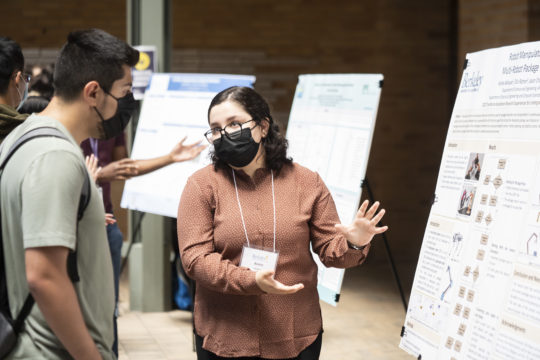
Undergraduate Researcher: Alahe Akhavan
Intended Major: Mechanical Engineering
Home Institution: American River College
Faculty Advisor: Claire J. Tomlin
Mentor: Ellis Ratner, Jason Choi
Project Abstract: Manipulator and quadruped robots are commonly used for package relocation and transportation in warehouses. Since creating a planning strategy that would enable multi-robot collaboration for these specific robots has been a challenge due to unpredictability with the prior algorithms during the interaction process, we introduce an integrated solution that coordinates multiple robots of both types to provide a seamless package transportation pipeline. Some challenges correlated to our study are related to motion planning and stability control. An important prior work related to this project has been on theoretical pipelines for planning purposes for the Quadruped robot, which has improved motion planning for different environments. We have concentrated on developing solutions that will allow both robots to complete a single continuous package transportation pipeline in a warehouse-like environment. As a result, the Manipulator robot should be able to relocate and place an object on the Quadruped robot to transfer it to a different location while avoiding obstacles along the way. View Alahe’s research poster.
Isolation and Characterization of Diverse Microorganisms Involved in Carbon Recycling
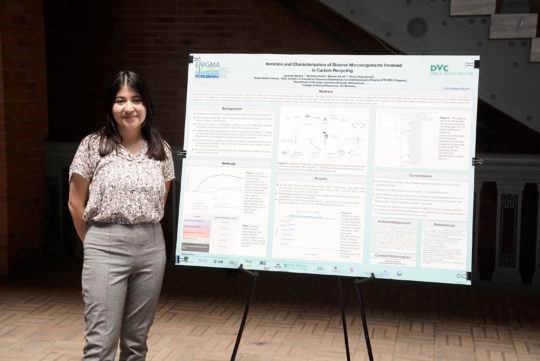 Undergraduate Researcher: Jasmine Amaya
Undergraduate Researcher: Jasmine Amaya
Intended Major: Bioengineering
Home Institution: Diablo Valley College
Faculty Advisor: Dr. Romy Chakraborty
Mentor: Dr. Brandon Enalls
Project Abstract: The metabolic diversity among microbes and their ubiquity in nature emphasize their vital roles in the global carbon cycle. Our group has previously enriched microbes from terrestrial subsurface environments using a wide variety of carbon sources, including organic matter extracted from sediments and microbial necromass. In previous works, we were able to culture a wider variety of microbes using these naturally occurring carbon sources. We expand upon this work by continuing to isolate and characterize microbes that can use microbial necromass as a carbon and energy source. To accomplish this, we are enriching the microbes in solid media using bacterial cell lysates that will simulate necromass found in nature. We can then extract and sequence the DNA from these isolates, allowing us to give them taxonomic assignments. The collection of isolated microbes is likely involved in recycling biological material in their native environments, highlighting their contribution to the carbon cycle. View Jasmine’s research poster.
Effect of Temperature and Device Size on the Switching Voltage of LCO Devices
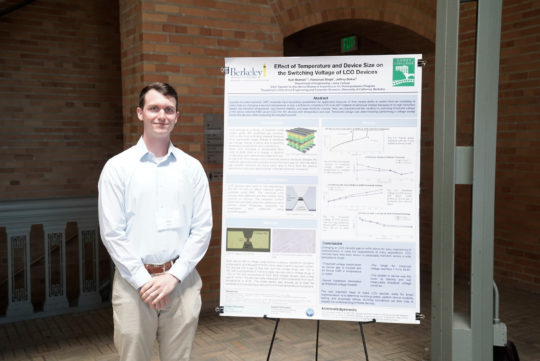
Undergraduate Researcher: Kyle Blanset
Intended Major: Mechanical Engineering
Home Institution: Laney College
Faculty Advisor: Jeffrey Bokor
Mentor: Dr. Hanuman Singh
Project Abstract: Insulator-to-metal transition (IMT) materials have boundless possibilities for application because of their simple ability to switch from an insulating to metal state by changing a device’s temperature or size. IMTs are of great importance for their use as memory elements and selector devices. Many other transition metal oxides exhibit IMT properties but either switch at an impractical temperature or have a low change in resistivity. Lanthanum cobaltite (LCO) is an IMT material of particular interest because of its high switching speed, low transition temperature, high thermal stability, and large resistivity change. Here, we characterized the variation in switching threshold voltage of the lattice-matched MBE-grown LCO thin film devices with temperature and size. Threshold voltage was determined by performing a voltage sweep across the devices while measuring the resultant current. View Kyle’s research poster.
Investigating Syntax-Guided Synthesis of Distributed Systems
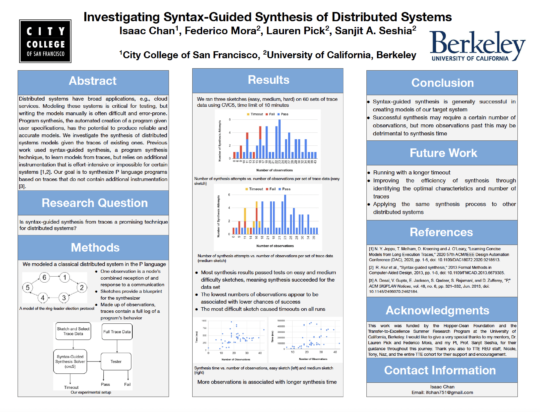 Undergraduate Researcher: Isaac Chan
Undergraduate Researcher: Isaac Chan
Intended Major: Computer Science
Home Institution: City College of San Francisco
Faculty Advisor: Sanjit A. Seshia
Mentor: Federico Mora, Dr. Lauren Pick
Project Abstract: From cloud computing services to flight control systems, distributed systems have broad and significant applications. However, distributed systems are often difficult to correctly implement. The modelling of these systems is a critical tool used for testing and debugging before their deployment. Despite the importance of creating these models, building them manually often poses difficulties due to the dissimilarities between distributed systems modelling languages and general high-level programming, as well as the relative lack of resources for these specialized languages. Program synthesis, the process of generating a program automatically given user specifications, has the potential to automate this process: eliminating the faults of manual creation, producing more accurate and reliable models. In this research, we investigated the synthesis of distributed systems models given the traces of existing ones. We found syntax-guided synthesis to be a promising technique for distributed systems. View Isaac’s research poster.
The Effects of Regularization on Robotic Performance
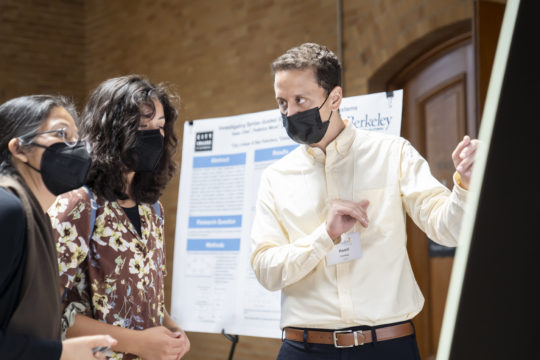
Undergraduate Researcher: Raaid Elmelegy
Intended Major:Electrical Engineering and Computer Sciences
Home Institution: Santa Monica College
Faculty Advisor: Jiantao Jiao
Mentor: Tianhao Wu
Project Abstract: Existing offline Reinforcement Learning (RL) algorithms aim to leverage previously collected datasets to learn effective policies without further exploration. However, in practice, the distributional shift between the learned policy and the policy used to collect the data often leads to over-estimation. In recent studies, pessimism was proven to resolve this issue by preventing over-estimation, leading to better performance. However, pessimism is difficult to implement in practice due to the large state and action spaces. This study aims to achieve both computationally efficient and theoretically guaranteed pessimism by investigating a family of regularization methods and leveraging the effect of regularization in Q-Learning. View Raaid’s research poster.
Automatic Curriculum Generation of Training Scenarios in Virtual Reality for an Efficient Skill Acquisition
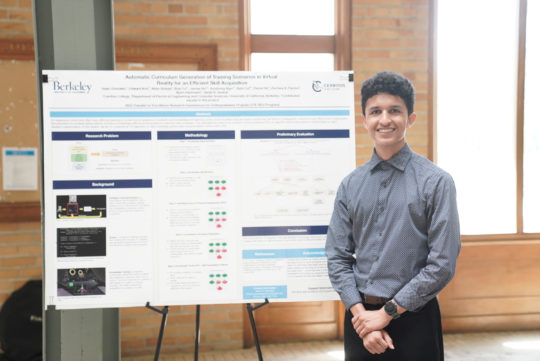
Undergraduate Researcher: Isaac Gonzalez
Intended Major: Computer Science
Home Institution: Cerritos College
Faculty Advisor: Sanjit A. Seshia
Mentor: Edward Kim
Project Abstract: One challenge students face in the classroom of today’s education system is the use of fixed curriculums for any type of subject. Every student who enters a class will come in with a variation of prior knowledge on what is needed for the class, and a variation in their learning curve, as some students are capable of learning the material faster than their peers. Students who need the extra help in a section of the subject would then attend the instructor’s office hours, but if the student:faculty ratio is high, this can pose a problem for the instructor to give each student personalized assistance. This is where an Intelligent Tutoring System (ITS) can come in to help, as it can give students a personalized curriculum to each of them depending on their input to the problems it gives them to solve. Using ITS for Virtual Reality (VR), other application domains such as rescue missions and sports could benefit from giving its trainee’s their own set of training scenarios aimed towards improving the skills they need to work on. Knowledge Tracing is used to track these skills on a knowledge graph and generate a curriculum based on how a trainee performs. For this project, the application domain being used is the Echo Arena VR game. View Isaac’s research poster.
Characterization and Fabrication of VxNbS2
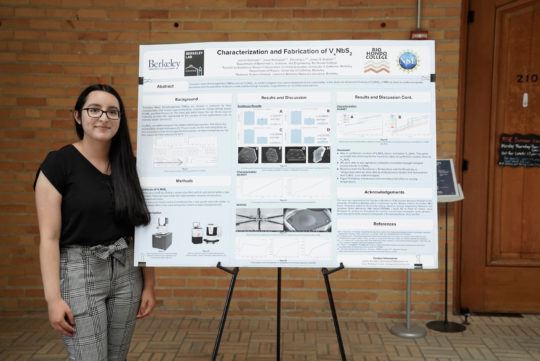
Undergraduate Researcher: Jasmin Gonzalez
Intended Major: Biochemistry
Home Institution: Rio Honda College
Faculty Advisor: James G. Analytis
Mentor: Josue Rodriguez
Project Abstract: Data loss is a major issue in modern electronics. Charged-based devices are vulnerable to ionizing radiation while ferromagnetic-based memory devices are susceptible to data loss from external magnetic fields. However Antiferromagnetic (AFM) based memory devices are robust to both charge and magnetic field perturbations. Here we present preliminary results to elucidate the possibility of electrical switchability of VxNbS2 a transition metal dichalcogenide (TMD) through transport, magnetization on nanofabricated devices. It was found that VxNbS2 displays antiferromagnetic transitions within its resistance vs temperature data in addition to a hysteresis and anomalous hall effect in the resistance vs magnetic field data. Utilizing this information it opens the possibility of electrical switchability of VxNbS2. View Jasmin’s research poster.
Integrated Photonic Wavelength Division Multiplexing for Trapped Ion Quantum Computing
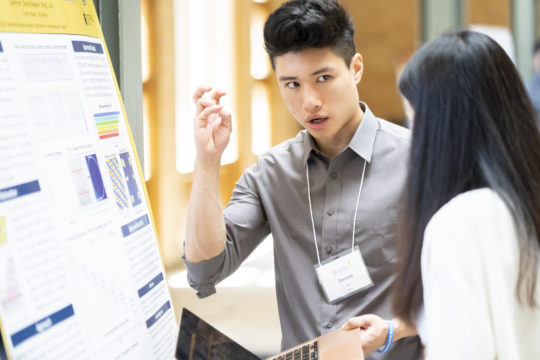
Undergraduate Researcher: Darren Ho
Intended Major: Electrical Engineering and Computer Sciences
Home Institution: Foothill College
Faculty Advisor: Ming C. Wu
Mentor: Daniel Klawson
Project Abstract: Trapped ions have emerged as a promising system for quantum computing (QC) due to their long coherence times, high gate fidelity, and qubit to qubit uniformity. Current methods for ion state manipulation and readout are typically implemented using bulk optics, which poses difficulties for scaling towards higher-qubit architectures. The use of photonics integrated into chip-scale surface electrode ion traps offer a potential hardware solution for improved scalability. As such, we explore and develop integrated wavelength division multiplexing (WDM) device designs for optimal light delivery and on-chip control of 133Ba+ qubits – of which requires six different wavelengths for state control and measurement. In particular, we evaluate the waveguide transmission performance of ring resonators with the various wavelengths used for 133Ba+. Lastly, considerations on reproducibility during the ring resonator WDM fabrication process are discussed. View Darren’s research poster.
Automatic Management of Cloud Resources for Distributed Systems Experiments
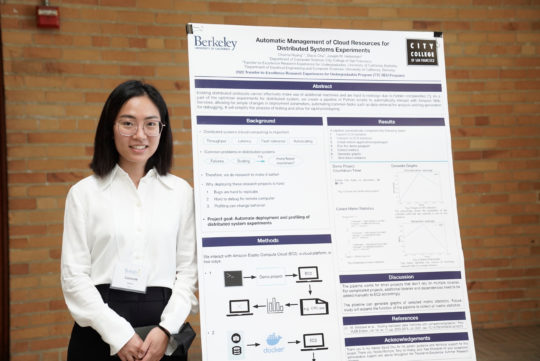
Undergraduate Researcher: Corrine Huang
Intended Major: Computer Science
Home Institution: City College of San Francisco
Faculty Advisor: Joseph M. Hellerstein
Mentor: David Chu
Project Abstract: Distributed systems provide high throughput, fault tolerance and availability using sets of computers in cooperation to process distributed tasks that monolithic systems cannot. But existing distributed protocols cannot effectively make use of additional machines and are hard to redesign due to hidden complexities. Our goal is to create an optimizer for distributed protocols and prove that the protocol’s behavior is preserved post-optimization. But testing distributed protocols is a mechanical yet difficult process with often irreplicable errors. We will create a pipeline of Python scripts to automatically interact with Amazon Web Services, allowing for simple changes in deployment parameters, automating common tasks such as data retrieval for analysis and log generation for debugging. It will simplify the process of testing and allow for rapid prototyping for research projects which aim to automatically increase the scalability and efficiency of distributed protocols, reducing the need for human interventions. View Corrine’s research poster.
Validation of Machine Learning-Driven Optimization of Chemical Vapor Deposition Showerhead Design
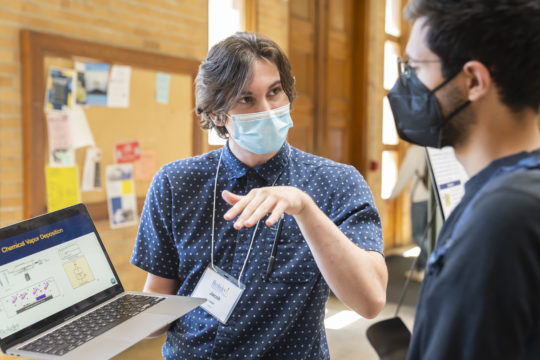
Undergraduate Researcher: Jacob Lopez
Intended Major: Mechanical Engineer
Home Institution: Fullerton College
Faculty Advisor: Grace Gu
Mentor: Daniel Lim
Project Abstract and poster not shared at faculty host and funder’s request
Quadrupedal Robot Implementation in Collaborative Planning for Package Transportation
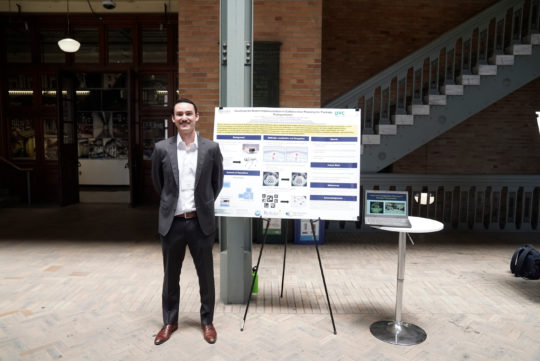
Undergraduate Researcher: Elias Lopez Morley
Intended Major: Electrical Engineering and Computer Sciences
Home Institution: Diablo Valley College
Faculty Advisor: Claire Tomlin
Mentor: Jason Choi, Ellis Ratner
Project Abstract: Robots have rapidly improved warehouse automation where distribution centers now rely on a variety of different robots for specific purposes. Traditionally this has been accomplished through the utilization of manipulators, whose purpose is to pick up and distribute packages, and wheeled robots, whose purpose is to transport the packages throughout the warehouse. Wheeled robots have several limitations, some of which include the inability to respond to dynamic and unstructured environments. It is common for warehouses to have stairs, ledges, sharp corners, and low friction terrain from dust and liquid. These types of obstacles highlight some of the limitations wheeled robots have in warehouses and illustrate the need to implement more versatile delivery robots. Our work entails implementing a cutting-edge robot known as a quadruped, which mimics the structure and movement of a four-legged animal with the aim to develop robust strategies to resolve uncertainties in both navigation and integration between robots. Specifically, this work concentrates on navigation and localization of the quadruped robot, coordination between the manipulator and the quadruped when distributing complex and diverse packages, and pathfinding under an unstable load. Our results demonstrate successful strategies and solutions for localizing and autonomously navigating a quadruped robot to a package transfer location. View Elias’s research poster.
Low Temperature Spin Coating of Two-Dimensional Molybdenum Disulfide

Undergraduate Researcher: Sela Murphy
Intended Major: Material Science and Engineering
Home Institution: Pasadena City College
Faculty Advisor: Zakaria Y. Al Balushi
Mentor: Ayush S. Gupta
Project Abstract: There is an ever-increasing demand for two-dimensional materials such as molybdenum disulfide (MoS2) for new thin film semiconductor devices. As a result, different deposition methods are being investigated to determine the best way to synthesize these materials; one popular synthesis method is spin coating which is an effective and economical way to deposit semiconductor films onto a substrate. In this paper, spin coating was utilized to create thin film samples of MoS2 at a low temperature. By adjusting parameters such as the precursor solution, type of substrate, rotation speed, temperature, and how long the sample was spun, uniform, thin films with thicknesses as small as 25 nm were obtained after Raman laser treatment. View Sela’s research poster.
The Effects of Using Multiple Wavelengths in Optical Diffraction Tomography
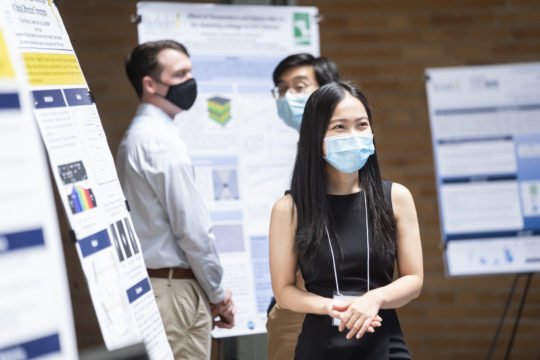
Undergraduate Researcher: Thi Lan Nhi Pham
Intended Major: Electrical Engineering and Computer Sciences
Home Institution: Chabot College
Faculty Advisor: Laura Waller
Mentor: Charles Dove
Project Abstract: In conventional microscopy, an image is collected by bending light using a simple lens. A significant problem with this method, however, is that it is hard to obtain 3D structures, especially with translucent, thick materials. To solve this, computational imaging combines the physics of light with computational modelling to reconstruct high-quality 3D images. Optical Diffraction Tomography (ODT) is a crucial computational imaging method which uses a reconstructive algorithm to make a 3D structure from pictures being taken by tilting light at different angles under a sample. In this research, we expand conventional ODT by using multiple wavelengths to get 2D images and the Multi-layer Born approximation to reconstruct 3D structure. View Thi’s research poster.
Constant-Memory Video Encoding for Language Grounding
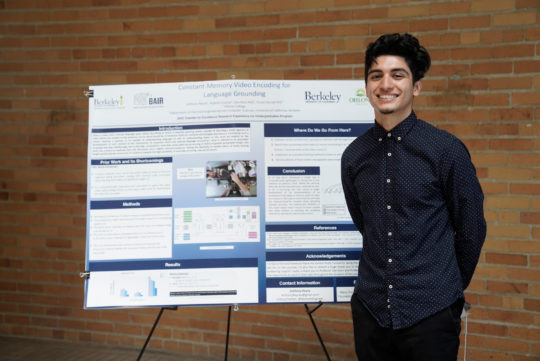
Undergraduate Researcher: Anthony Reyna
Intended Major: Computer Science
Home Institution: Ohlone College
Faculty Advisor: Dan Klein
Mentor: Rodolfo Corona Rodriguez
Project Abstract: A system capable of receiving a question and returning a small segment of video containing the answer would have useful applications in assistive technologies. Current video deep learning systems used in this domain search the entire video for every sentence to find the segments being described, making GPU memory costs untenable when dealing with videos of significant length. Furthermore, it’s computationally expensive and redundant to query the same video with multiple sentences as the entire video must be reprocessed for each sentence. In this work, we explore an implementation of a memory-augmented multiscale vision transformer, a video encoding system, in order to process videos of arbitrary length while keeping memory costs constant. By using this method, the system would only process the video once and be capable of localizing segments for multiple sentences.
For our ongoing experiments, we train our model on 240 hours of the Ego4D dataset — consisting of first person-perspective video with accompanying descriptive-captions. We compare the accuracy of our system’s returned video segments, with the correct descriptive caption, against established baselines. We expect to show that the static memory footprint method proposed can perform comparably or better to prior work in this domain, while simultaneously relaxing assumptions that the entire video must be reprocessed for each given sentence. If our method is successful, it would improve on the current state-of-the-art by significantly improving scalability to arbitrarily long videos by keeping both memory costs and computation costs down. View Anthony’s research poster.
Creation of Hexagonal Boron Nitride Vacancy Defects
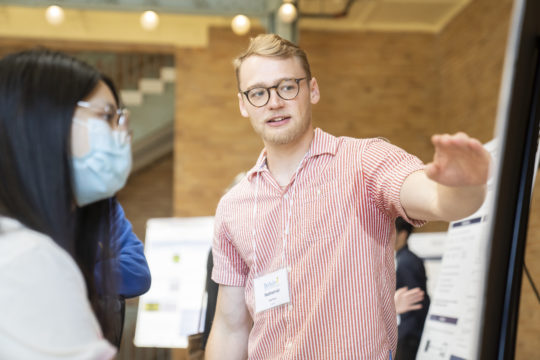
Undergraduate Researcher: Nathaniel Seymour
Intended Major: Mechanical Engineering
Home Institution: Cuesta College
Faculty Advisor: Alex Zettl
Mentor: Chunhui Dai
Project Abstract: Using ion implantation techniques to induce Boron vacancy is a proven way to create near room temperature, photostable quantum emitters in hexagonal boron nitride. These emitters have promising applications as their spin states are optically addressable and have the highest recorded brightness among the known quantum emitting materials. Despite these useful properties, the creation of these quantum emitters and their properties require further investigation. We are studying how irradiation dose affects the density and depth of negatively charged boron vacancy by creating defects using a Helium Ion Microscope and characterizing the defect density through RAMAN spectroscopy. Understanding these relationships could help further optimize the intentional creation and manipulation of VB- defects in hexagonal Boron Nitride. View Nathaniel’s research poster.